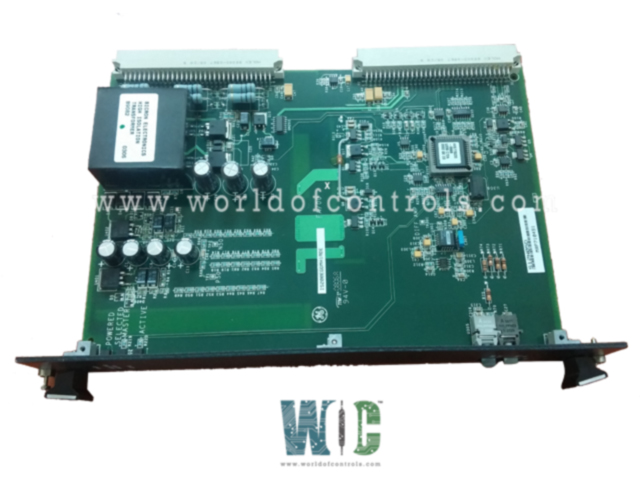
World Of Controls understands the criticality of your requirement and works towards reducing the lead time as much as possible.
IS200EGDMH1AFG - Exciter Ground Detector Module is available in stock which ships the same day.
IS200EGDMH1AFG - Exciter Ground Detector Module comes in UNUSED as well as REBUILT condition.
To avail our best deals for IS200EGDMH1AFG - Exciter Ground Detector Module, contact us and we will get back to you within 24 hours.
SPECIFICATIONS:
Part Number: IS200EGDMH1AFG
Manufacturer: General Electric
Series: EX2100
Product Type: Exciter Ground Detector Module
Number of channels: 12
Input span: 4-20 mA
Technology: Surface Mount
Common Mode Voltage Range: ±5 V
Maximum Lead Resistance: 15Ω
Analog output current: 0-20 mA
Operating temperature: -30 to 65 °C
Size: 8.26 cm high x 4.19 cm
Repair: 3-7 Day
Availability: In Stock
Country of Origin: United States
Manual: GEI-100467
FUNCTIONAL DESCRIPTION:
IS200EGDMH1AFG is an Exciter Ground Detector Module manufactured and designed by General Electric as part of the EX2100 Series used in GE Excitation Control Systems. The IS200EGDMH1 Ground Detection Module is used in the EX2100 Excitation Control. It is a double slot, double height (6U) form factor board that mounts in the Exciter Power Backplane rack (EPBP). The field ground detector detects field leak-age resistance between any point in the generator field circuit to the ground, either on the ac or dc side. A simplex system will have one EGDM, and a redundant system will have three. The location of the EGDM(s) is shown in Figure 1. EXAM, the attenuator module, senses the voltage across the ground sense resistor and sends the signal to the EGDM(s) over a nine-conductor cable. The EXAM module is mounted in the High Voltage Module located in the Auxiliary Panel.
In a redundant control, the set of three EGDM boards is configured as Controller (C), Master 1 (M1), and Master 2 (M2). The configuration for each EGDM is controlled by a set of program pins on the P2 connector. Information on which master provides the drive signal to the sense resistor in the Attenuator Module is sent from the DSPX, through the EISB in the controller rack, to EGDM C. Upon receiving this information over the fiber-optic link, C either powers the relay in the Attenuator Module if M2 is the driver, or leaves it unpowered if M1 is the chosen master. At the same time, a differential signal is sent to M1 and M2 that indicates the chosen master. This signal enables the signal generator on the active master and selects the test command source on each module (M1, M2, and C). Now the active master receives an Oscillator Signal over the fiber optic link from the DSPX through the EISB that it converts to a positive or negative 50-volt signal. This square wave voltage is sent by cable to the EXAM module and applied to one end of the Sense Resistor.
The signal conditioner receives an attenuated (10:1) differential signal from the Sense Resistor in the EXAM module. The signal conditioner is a simple unity gain differential amplifier with a high common-mode rejection ratio followed by an A-to-D converter (Voltage Controlled Oscillator VCO). The VCO feeds a fiber optic transmitter. The signal conditioner circuitry is powered by an isolated power supply to maintain personnel and equipment safety due to the high common-mode voltage at the Sense Resistor. The signal conditioner can measure the power amplifier output level by grounding the bridge side of the attenuated Sense Resistor on command from the control section.
FEATURES:
WOC has the largest stock of GE Excitation Control System Replacement Parts. We can also supply unused and rebuilt backed-up with a warranty. Our team of experts is available round the clock to support your OEM needs. Our team of experts at WOC is happy to assist you with any of your automation requirements. For pricing and availability on any parts and repairs, kindly contact our team by phone or email.
How does an Exciter Ground Detector Module work?
The module monitors the insulation resistance between the exciter field winding and the ground. It typically uses a high-impedance voltage source to apply a test voltage and measure the resulting current. If the resistance falls below a predetermined threshold, indicating a possible ground fault, the module triggers an alarm or a protective action.
Why is it important to use an Exciter Ground Detector Module?
Using an Exciter Ground Detector Module is crucial for maintaining the reliability and safety of generator excitation systems. Ground faults can cause damage to the generator, reduce efficiency, and pose safety hazards. Detecting these faults early allows for timely maintenance and prevents more severe issues.
How are boards packaged for shipment from WOC?
Parts are placed in antistatic packets and securely packed in ESD boxes cushioned with ESD Foam designed to safeguard electrical components.